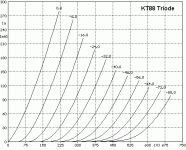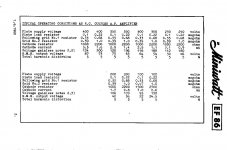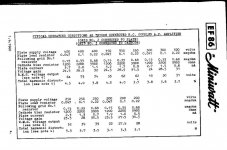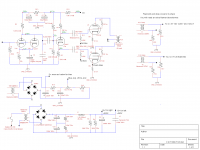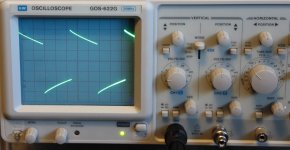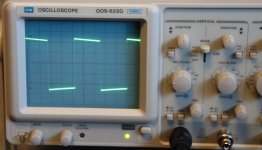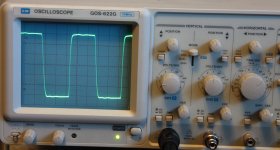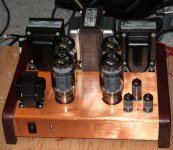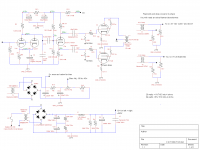I googled around for EF86-triode specs. Found the Klausmobile test for 6J32P wired as triode (Russian equivalent to EF86). Tube Tester Files - 6J33P (EF86)
It says the amplification factor is about 25 to 32. Let's say it's 25.
If you have a 1.5V rms input signal at the input, that's about a 2.1V peak input.
If the amp factor is 25, then the max output from the first (voltage amp) stage is about 50V peak.
That will be going through the cathodyne phase-splitter stage, which will have a gain of about 0.9, so that 50V gets chopped down to about 45V peak to the KT120-triode output stage.
Is that enough to drive KT120's to full power at the operating points you're running them? Or are you using a preamp with gain in front of this amp?
-RG
Either using my pre-amp or direct from my Oppo-105 which lists output as 2v.
Datasheet: http://www.r-type.org/pdfs/ef86-1.pdf
The EF-86's are biasing up with a B+ of 350v and then 142v on the plate and 3v on the cathode (3mA)
Apparently some grid stoppers are in order....
Will install and get back to testing in a few days.
Either using my pre-amp or direct from my Oppo-105 which lists output as 2v.
Datasheet: http://www.r-type.org/pdfs/ef86-1.pdf
The EF-86's are biasing up with a B+ of 350v and then 142v on the plate and 3v on the cathode (3mA)
Apparently some grid stoppers are in order....Tried to get away without.
Will install and get back to testing in a few days.
Cool. Figure 2V rms = 2.8V peak.
2.5V(25) = 62.5V
I guess that leaves the question of what the bias is on the KT120s. If the bias is less than or equal to about -55V (grid to ground) then you should be able to use the amp without a preamp with gain.
Whether or not a 12AU7 cathodyne is capable of driving the grid capacitance of the KT120-triode with low distortion and no slewing is a separate question. There's a formula for figuring that out somewhere...
slew_rate [Electron Coaxing Techniques & Notes]
slew rate explained | ken-gilbert.com
Re: slewing, I guess the question is 'how much current is drawn by the 12AU7?' I think 6mA or so should work well enough, right? (Someone should check my work on this. I'm a neophyte at this stuff.)
Triode drive for KT88-KT120
Could not find the drive needed for Triode KT120's, but found for KT88.
With cathode bias you need depending on the plate voltage: 400 volts 78 volts, 485 needs 114 volts. The preamp output voltage has nothing to do with how well the drive circuit drives the KT120's/KT88.
Phil
Could not find the drive needed for Triode KT120's, but found for KT88.
With cathode bias you need depending on the plate voltage: 400 volts 78 volts, 485 needs 114 volts. The preamp output voltage has nothing to do with how well the drive circuit drives the KT120's/KT88.
Phil
Attachments
Could not find the drive needed for Triode KT120's, but found for KT88.
With cathode bias you need depending on the plate voltage: 400 volts 78 volts, 485 needs 114 volts. The preamp output voltage has nothing to do with how well the drive circuit drives the KT120's/KT88.
Phil
yes absolutely. It's the EF86 that is the voltage amp, Not a preamp you put in front of that. The question is what is the operating point of the KT120s? If biased w low plate volts and high plate current, then might be okay. If more like what you mentioned then exactly! Not gonna make full power before driver stage gives out.
If you look at the KT88 data, in the Push Pull. Class AB1. Cathode Bias. Triode Connection section, it says that with plate voltage = 400V, quiescent plate current = 76mA (each), into a load of 4k ohms plate-plate, the grid bias should be about -40V.
I've attached KT88 triode curves from Sofia. They suggest that KT88-triode could be used at about Va = 450V, Vg1 = -48V for Ia = 75mA.
That doesn't use all that the KT88-triode is capable of, but would be a reasonable op point, and would just barely work with the driver stage proposed. I'm not saying I think the proposed driver stage is a great solution, I'm just saying it should work. Of course, I may have missed something or be mistaken about something. I welcome corrections, since that's how ya learn, right?
--
PS -- I've had this discussion before, and found it confusing. My understanding is that the driver stage is called on to supply peak volts to the outputs. If a push-pull driver, then you can look at it as a single-ended stage with mirror-image other half. A 6SN7 with 4V in and 15X gain can deliver 60V peak, if used as a push-pull driver.
How that equates to a cathodyne might be very different. Are you saying the single-ended EF86-triode (into a cathodyne) has to supply 90V peak output to drive a push-pull output stage that has a grid bias of -45V (so 90V peak-to-peak drive voltage required)?
--
I've attached KT88 triode curves from Sofia. They suggest that KT88-triode could be used at about Va = 450V, Vg1 = -48V for Ia = 75mA.
That doesn't use all that the KT88-triode is capable of, but would be a reasonable op point, and would just barely work with the driver stage proposed. I'm not saying I think the proposed driver stage is a great solution, I'm just saying it should work. Of course, I may have missed something or be mistaken about something. I welcome corrections, since that's how ya learn, right?
--
PS -- I've had this discussion before, and found it confusing. My understanding is that the driver stage is called on to supply peak volts to the outputs. If a push-pull driver, then you can look at it as a single-ended stage with mirror-image other half. A 6SN7 with 4V in and 15X gain can deliver 60V peak, if used as a push-pull driver.
How that equates to a cathodyne might be very different. Are you saying the single-ended EF86-triode (into a cathodyne) has to supply 90V peak output to drive a push-pull output stage that has a grid bias of -45V (so 90V peak-to-peak drive voltage required)?
--
Attachments
Last edited:
ef86 data for Pentode and triode.
Data for EF86.
Also the max resistance in the grid for the KT120 is only 50k with fixed bias, this is the case with most current production Tubes including the KT88's, if you want them to last. The original GEC KT88 it was 100K; 250k with cathode bias.
With push pull drivers you can use 39k grid resistors Fixed bias and longer tube life, worth while when the tubes cost $US 60.00 each.
Phil
Data for EF86.
Also the max resistance in the grid for the KT120 is only 50k with fixed bias, this is the case with most current production Tubes including the KT88's, if you want them to last. The original GEC KT88 it was 100K; 250k with cathode bias.
With push pull drivers you can use 39k grid resistors Fixed bias and longer tube life, worth while when the tubes cost $US 60.00 each.
Phil
Attachments
Melb,
The 290HX is fine for your project but I thought I'd point out a potential problem to other folk looking at this.
The 356V C.T. (178-0-178) @ 420mA rating is dependent upon you drawing current from one side of the centre tap ONLY on each half cycle.
When you use a bridge rectifier across the full secondary and leave the centre tap disconnected (as you have done) this halves the current rating. Thus it becomes a 365V @ 210mA rated tranny. 210mA is probably adequate for your amp so not an issue, but something to be aware of, if you were'nt already.
Cheers,
Ian
The 290HX is fine for your project but I thought I'd point out a potential problem to other folk looking at this.
The 356V C.T. (178-0-178) @ 420mA rating is dependent upon you drawing current from one side of the centre tap ONLY on each half cycle.
When you use a bridge rectifier across the full secondary and leave the centre tap disconnected (as you have done) this halves the current rating. Thus it becomes a 365V @ 210mA rated tranny. 210mA is probably adequate for your amp so not an issue, but something to be aware of, if you were'nt already.
Cheers,
Ian
gingertube
The 290HX is fine for your project but I thought I'd point out a potential problem to other folk looking at this.
The 356V C.T. (178-0-178) @ 420mA rating is dependent upon you drawing current from one side of the centre tap ONLY on each half cycle.
When you use a bridge rectifier across the full secondary and leave the centre tap disconnected (as you have done) this halves the current rating. Thus it becomes a 365V @ 210mA rated tranny. 210mA is probably adequate for your amp so not an issue, but something to be aware of, if you were'nt already.
Cheers,
Ian
I recently ordered a transformer using a bridge rectifier; one of my friends ordered a transformer for the same voltage but full wave Bi phase half wave { centre tap} otherwise all the heater winding’s were the same. Mine weighs 7 kilo the Bi Phase weighs 13 kilo. The bridge circuit results in a smaller transformer used more efficiently. Wouldn’t the current reduction be more like one third not half. Also I have used centre tapped transformers rated 175 ma with a bridge and drawn 200ma with no sign of even warming up, even after running for hours. still using the amp 20 years later two 845's running at 90ma each.
Maybe I have been lucky or very good transformers.
phil
The 290HX is fine for your project but I thought I'd point out a potential problem to other folk looking at this.
The 356V C.T. (178-0-178) @ 420mA rating is dependent upon you drawing current from one side of the centre tap ONLY on each half cycle.
When you use a bridge rectifier across the full secondary and leave the centre tap disconnected (as you have done) this halves the current rating. Thus it becomes a 365V @ 210mA rated tranny. 210mA is probably adequate for your amp so not an issue, but something to be aware of, if you were'nt already.
Cheers,
Ian
I recently ordered a transformer using a bridge rectifier; one of my friends ordered a transformer for the same voltage but full wave Bi phase half wave { centre tap} otherwise all the heater winding’s were the same. Mine weighs 7 kilo the Bi Phase weighs 13 kilo. The bridge circuit results in a smaller transformer used more efficiently. Wouldn’t the current reduction be more like one third not half. Also I have used centre tapped transformers rated 175 ma with a bridge and drawn 200ma with no sign of even warming up, even after running for hours. still using the amp 20 years later two 845's running at 90ma each.
Maybe I have been lucky or very good transformers.
phil
Actually from the Hammond site they have a good design guide. My take is that the current is 0.62 times the rated current so should be 420mA x 0.62 = 260mA And that should be a continuous rating. The 290HX is a drop in replacement for a 100 watt Marshall Amp.gingertube
The 290HX is fine for your project but I thought I'd point out a potential problem to other folk looking at this.
The 356V C.T. (178-0-178) @ 420mA rating is dependent upon you drawing current from one side of the centre tap ONLY on each half cycle.
When you use a bridge rectifier across the full secondary and leave the centre tap disconnected (as you have done) this halves the current rating. Thus it becomes a 365V @ 210mA rated tranny. 210mA is probably adequate for your amp so not an issue, but something to be aware of, if you were'nt already.
Cheers,
Ian
I recently ordered a transformer using a bridge rectifier; one of my friends ordered a transformer for the same voltage but full wave Bi phase half wave { centre tap} otherwise all the heater winding’s were the same. Mine weighs 7 kilo the Bi Phase weighs 13 kilo. The bridge circuit results in a smaller transformer used more efficiently. Wouldn’t the current reduction be more like one third not half. Also I have used centre tapped transformers rated 175 ma with a bridge and drawn 200ma with no sign of even warming up, even after running for hours. still using the amp 20 years later two 845's running at 90ma each.
Maybe I have been lucky or very good transformers.
phil
http://www.hammondmfg.com/pdf/5c007.pdf
yes absolutely. It's the EF86 that is the voltage amp, Not a preamp you put in front of that. The question is what is the operating point of the KT120s? If biased w low plate volts and high plate current, then might be okay. If more like what you mentioned then exactly! Not gonna make full power before driver stage gives out.
I'm thinking you are quite correct. I'm biasing the KT120s at -55 volts. I have a set of KT88's I might try. I'm thinking they will bias lower and be easier to drive, but I'm thinking that going to a 12ax7 for a voltage amp will solve all my problems.
I'm living on the edge with my 100k grid resistors.
I'm really not too worried about it with the separate bias adjustments for the tubes. My experience with tubes is once they run away they are done anyhow and I have had tubes that have run away and been brand new AND in a totally correct (spec. sheet perfect) installment.
Back.....
After trying a bunch of different configurations I have come up with the attached schematic.
It makes 30 watts at 3.2% distortion and 10 watts at 1% distortion with no feedback. This is using the 8 ohm connection on the Hammond 1650N into a 6.8 ohm resistor. Next thing I will do is put in my KT88's to see how they compare
I found out you are not going to be able to directly connect a 12ax7 to a cathodyne no matter how hard you try and still have enough drive. I got the grid bias idea for the cathodyne from the Valve Wizard. (See his page on Cathodynes)
The Valve Wizard
After trying a bunch of different configurations I have come up with the attached schematic.
It makes 30 watts at 3.2% distortion and 10 watts at 1% distortion with no feedback. This is using the 8 ohm connection on the Hammond 1650N into a 6.8 ohm resistor. Next thing I will do is put in my KT88's to see how they compare
I found out you are not going to be able to directly connect a 12ax7 to a cathodyne no matter how hard you try and still have enough drive. I got the grid bias idea for the cathodyne from the Valve Wizard. (See his page on Cathodynes)
The Valve Wizard
Attachments
Melb.
You should try 6GU7/12BH7 Much lower plate resistance than the 12AU7 and 6CG7.
The 6GU7 even has the same pin out. The Russian 6N6 has even lower plate resistance so even better and again the same pin out as the 6CG7. 12Ax7's make very poor drivers due to the high plate resistance.
Phil
You should try 6GU7/12BH7 Much lower plate resistance than the 12AU7 and 6CG7.
The 6GU7 even has the same pin out. The Russian 6N6 has even lower plate resistance so even better and again the same pin out as the 6CG7. 12Ax7's make very poor drivers due to the high plate resistance.
Phil
Phil: I received my 6GU7's today. I got 2 NOS RCA in nice boxes on ebay for $32.00 including shipping. I can now make 31.6 watts at 2% THD. And my 1% THD point is at 16 watts.
I will have to set some time aside to see if I can hear a difference between the different tubes....somehow I doubt it, but it is nice to know the amp is a bit more optimized, thanks.
I will have to set some time aside to see if I can hear a difference between the different tubes....somehow I doubt it, but it is nice to know the amp is a bit more optimized, thanks.
Melb.
Glad the 6GU7 improved your amp. I made a 100 watt pp amp and could not get the 12BH7 or 6GU7 in Australia so I used the 6SN7 could only get 30 watts. Eventually Imported some 6Gu7 from The USA and the amp easily put out over 100 watts.
You may get even better results with the Russian or Chinese 6N6.
Phil
Glad the 6GU7 improved your amp. I made a 100 watt pp amp and could not get the 12BH7 or 6GU7 in Australia so I used the 6SN7 could only get 30 watts. Eventually Imported some 6Gu7 from The USA and the amp easily put out over 100 watts.
You may get even better results with the Russian or Chinese 6N6.
Phil
Think I am done.
I tweaked the resistor values on the driver (12ax7) and this was the best I could get. I'm hoping at this point I'm driving the KT120's to their max.
Here are some scope shots at 100, 1000 and 10K square waves...I think it looks pretty good! And the final for now schematic.
This thing sounds pretty darn good.
I tweaked the resistor values on the driver (12ax7) and this was the best I could get. I'm hoping at this point I'm driving the KT120's to their max.
Here are some scope shots at 100, 1000 and 10K square waves...I think it looks pretty good! And the final for now schematic.
This thing sounds pretty darn good.
Attachments
- Status
- This old topic is closed. If you want to reopen this topic, contact a moderator using the "Report Post" button.
- Home
- Amplifiers
- Tubes / Valves
- KT120 "triode" and Hammond 1650N
